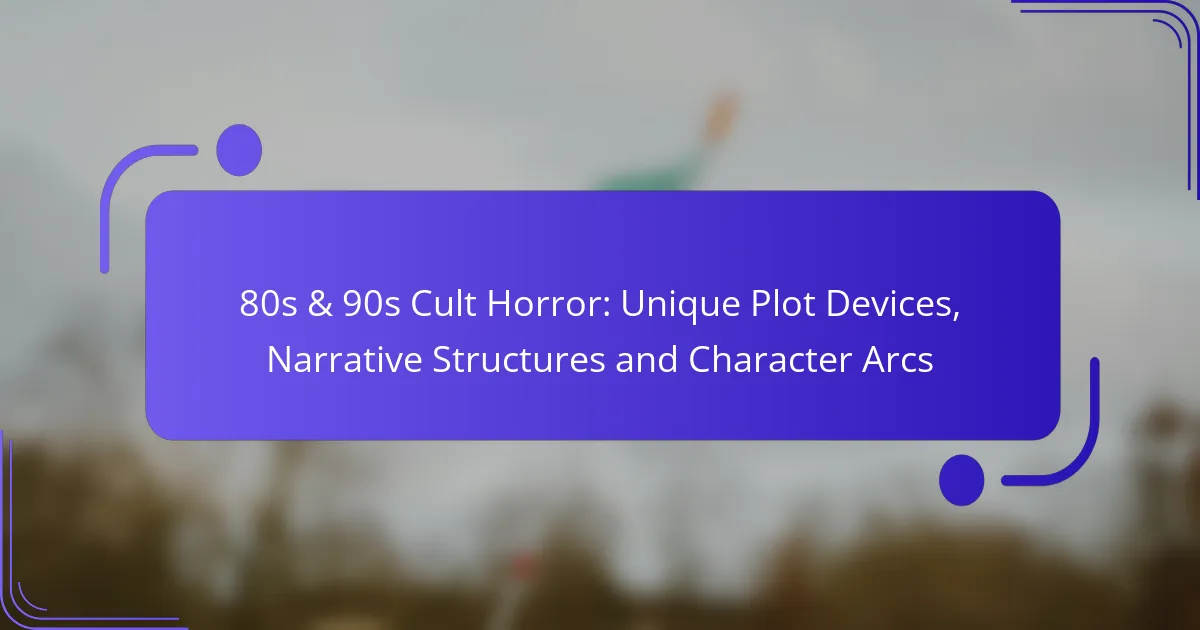The cult horror films of the 80s and 90s are renowned for their innovative plot devices that defy traditional storytelling, captivating audiences with unexpected twists and heightened suspense. Through diverse narrative structures, these films create immersive experiences that resonate emotionally, while character arcs often focus on transformation and survival, adding depth to the horror. This unique blend of creativity and emotional engagement solidifies their place in the genre’s legacy.

You can explore more about the genre’s legacy on our homepage.
What Unique Plot Devices Define 80s & 90s Cult Horror?
Unique plot devices in 80s and 90s cult horror films often include elements that challenge conventional storytelling, creating memorable and engaging experiences. These devices enhance suspense, surprise, and viewer engagement, making the films stand out in the horror genre.
Unreliable Narrators
Unreliable narrators are a common device in cult horror, where the perspective of the storyteller may distort reality. This technique creates tension and uncertainty, as viewers must question what is true and what is fabricated. Films like “The Shining” exemplify this, as the protagonist’s mental state leads to a skewed perception of events.
When employing an unreliable narrator, consider how their perspective can mislead the audience. This can heighten suspense and create twists that keep viewers guessing. However, ensure that the eventual reveal is satisfying and not overly convoluted.
Twists and Turns
Twists and turns are essential in maintaining suspense and intrigue in cult horror films. These unexpected plot developments can dramatically alter the story’s direction, often leading to shocking revelations about characters or events. A classic example is “The Sixth Sense,” where the final twist redefines the entire narrative.
To effectively incorporate twists, build up clues throughout the film that hint at the eventual reveal without making it obvious. This balance keeps the audience engaged while still allowing for surprise. Avoid clichés that may make twists feel predictable or forced.
Meta-Narratives
Meta-narratives involve self-referential storytelling that acknowledges the conventions of horror films. This device can create a unique viewing experience by blending humor and horror, as seen in “Scream.” By breaking the fourth wall, these films invite viewers to reflect on genre tropes and their expectations.
When using meta-narratives, ensure that the humor complements the horror elements rather than undermining them. This balance can enhance the film’s appeal and create a more engaging experience for audiences familiar with horror conventions.
Non-Linear Storytelling
Non-linear storytelling disrupts chronological order, allowing for a more complex narrative structure. This technique can create suspense and intrigue, as seen in films like “Pulp Fiction,” where the fragmented timeline invites viewers to piece together the story. Such structures can enhance thematic depth and character development.
To effectively use non-linear storytelling, carefully plan how each segment connects to the overall narrative. Ensure that transitions are clear enough to avoid confusing the audience. This approach can deepen engagement and encourage multiple viewings to uncover hidden layers.
Anthology Formats
Anthology formats consist of multiple short stories or segments within a single film, each with its own narrative arc. This structure allows for diverse storytelling and can showcase various horror styles, as seen in “Creepshow.” Each segment can explore different themes or tones, appealing to a broader audience.
When creating an anthology, ensure that each story maintains a cohesive tone or theme to unify the film. This can enhance viewer satisfaction and create a memorable experience. Avoid segments that feel disjointed or unrelated, as this can detract from the overall impact.
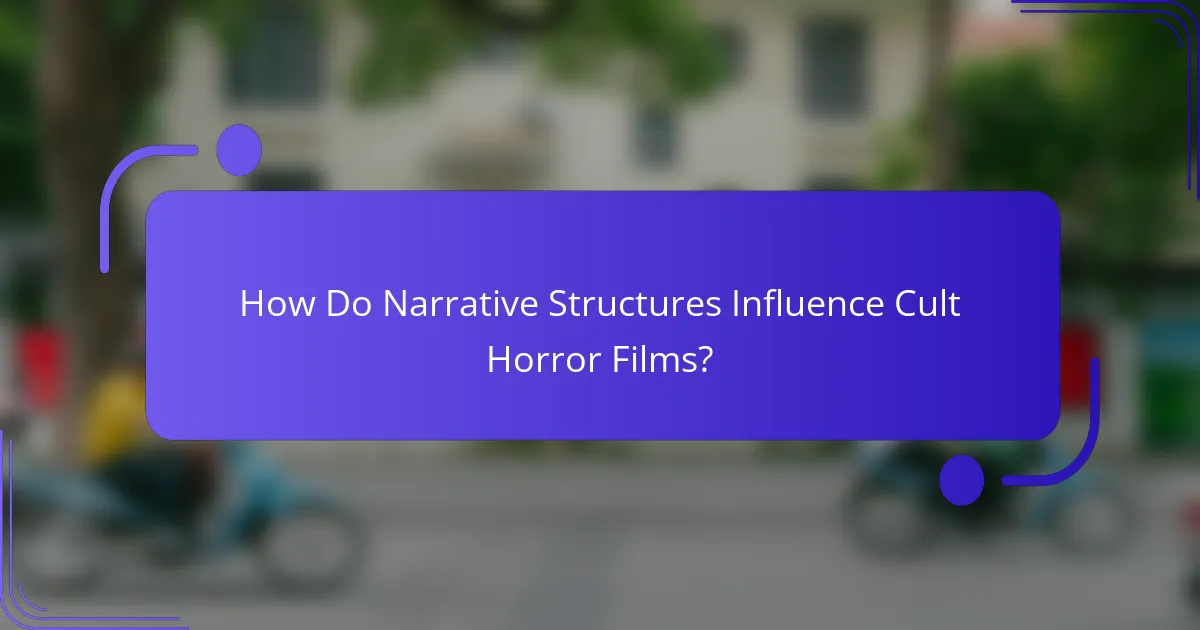
How Do Narrative Structures Influence Cult Horror Films?
Narrative structures play a crucial role in shaping the storytelling of cult horror films, often enhancing suspense and emotional engagement. By employing various frameworks, filmmakers can create unique experiences that resonate with audiences and elevate the horror elements.
You can explore more about these techniques in cult horror movie tropes.
Three-Act Structure
The three-act structure is a classic narrative framework that divides a story into setup, confrontation, and resolution. In cult horror films, this structure often establishes a relatable protagonist, introduces a terrifying conflict, and culminates in a climactic showdown with the antagonist. For example, films like “A Nightmare on Elm Street” effectively use this format to build tension and deliver satisfying resolutions.
When utilizing the three-act structure, filmmakers should focus on pacing and character development. Ensuring that each act flows logically into the next helps maintain audience engagement. A common pitfall is rushing through the resolution, which can leave viewers feeling unsatisfied.
Fractured Narratives
Fractured narratives disrupt chronological storytelling, presenting events out of order to create intrigue and suspense. This technique can enhance the horror experience by revealing key plot points gradually, keeping the audience guessing. Films like “The Shining” use this approach to build an unsettling atmosphere and deepen the psychological horror.
To effectively implement a fractured narrative, filmmakers should carefully plan the sequence of events to ensure clarity despite the non-linear presentation. A well-executed fractured narrative can lead to powerful revelations and emotional impacts, but it risks confusing viewers if not handled skillfully.
Character-Driven Arcs
Character-driven arcs focus on the emotional and psychological development of characters throughout the film. In cult horror, these arcs often highlight the transformation of protagonists as they confront their fears and the horrors around them. For instance, “The Texas Chainsaw Massacre” showcases the evolution of its characters as they face life-or-death situations.
When crafting character-driven arcs, it’s essential to create relatable and complex characters that audiences can connect with. This connection amplifies the horror elements, as viewers become invested in the characters’ fates. Avoiding one-dimensional characters is crucial, as they can undermine the emotional weight of the narrative.
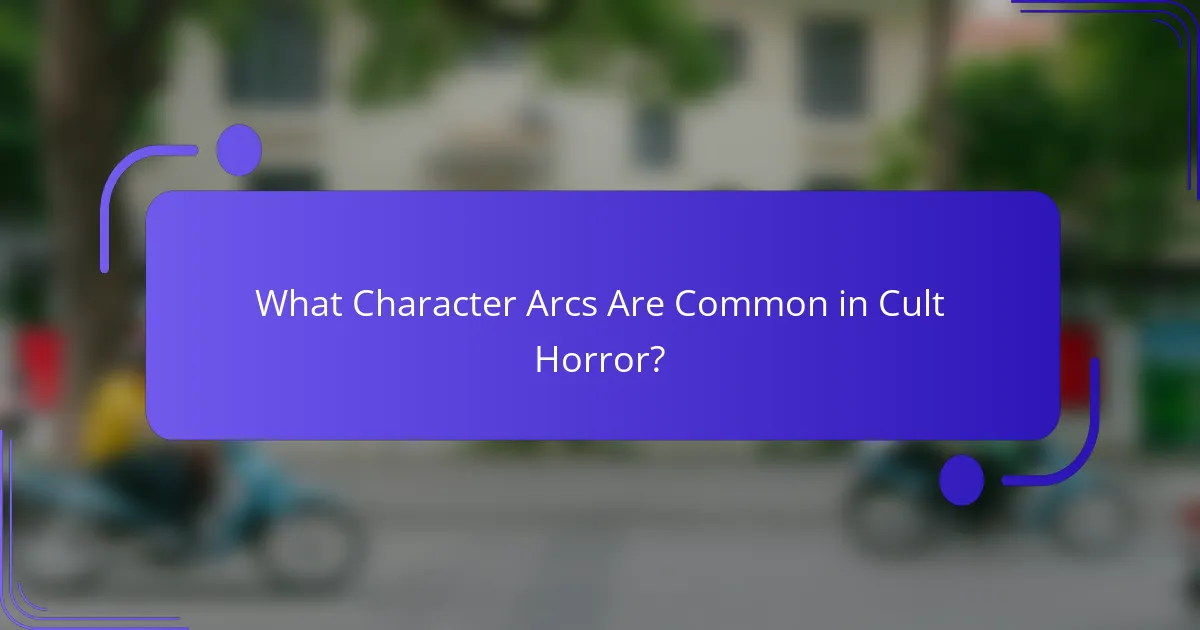
What Character Arcs Are Common in Cult Horror?
Common character arcs in cult horror often revolve around transformation, survival, and anti-hero development. These arcs drive the narrative and enhance the emotional impact, making them essential elements in the genre.
Transformation Arcs
Transformation arcs typically involve characters undergoing significant changes, often as a result of traumatic experiences. This can manifest as a shift from innocence to a hardened survivor or from sanity to madness. For example, a character may start as a naive teenager and evolve into a resourceful fighter against supernatural forces.
These arcs can serve to highlight themes of resilience or the loss of humanity. The transformation often reflects the character’s internal struggle, making their journey relatable and compelling for the audience.
Survivor Archetypes
Survivor archetypes are central to many cult horror narratives, representing characters who endure horrific circumstances. These characters often possess traits such as resourcefulness, bravery, and a strong will to live. They may face overwhelming odds, yet their determination drives the plot forward.
Common examples include the final girl trope, where a female character survives to confront the antagonist, often embodying purity or moral strength. This archetype resonates with audiences, as it emphasizes the triumph of the human spirit in the face of terror.
Anti-Hero Development
Anti-hero development involves characters who lack traditional heroic qualities but still engage the audience’s sympathy. These characters often operate outside moral boundaries, making choices that can be questionable or selfish. Their complexity adds depth to the narrative, challenging viewers’ perceptions of good and evil.
In cult horror, anti-heroes may start as villains or morally ambiguous figures, gradually revealing their motivations and vulnerabilities. This evolution can create a compelling tension, as audiences may find themselves rooting for characters who are not conventionally heroic.

Which 80s & 90s Cult Horror Films Exemplify These Elements?
Several cult horror films from the 80s and 90s showcase unique plot devices, narrative structures, and character arcs. Notable examples include “The Shining,” “Nightmare on Elm Street,” and “Donnie Darko,” each contributing distinct elements that define the genre.
The Shining
“The Shining,” directed by Stanley Kubrick, utilizes a non-linear narrative structure that enhances its psychological horror. The film’s exploration of isolation and madness is exemplified through Jack Torrance’s gradual descent into insanity, driven by supernatural forces within the Overlook Hotel.
The use of visual motifs, such as the haunting imagery of the twins and the blood-filled elevator, reinforces the film’s themes. The character arcs, particularly Jack’s transformation from a struggling writer to a violent figure, illustrate the impact of the hotel’s malevolent influence.
Nightmare on Elm Street
The narrative structure employs a cyclical approach, with characters facing repeated encounters with Freddy, leading to escalating tension. The character arcs of Nancy and her friends highlight themes of fear and resilience, as they confront their worst nightmares to survive.
Donnie Darko
“Donnie Darko” combines elements of psychological thriller and science fiction, featuring a complex narrative that intertwines time travel and mental health. The film’s plot revolves around Donnie’s visions of a mysterious figure in a rabbit suit, prompting him to question reality and his place in the universe.
The character arc of Donnie showcases his struggle with adolescence, mental illness, and existential dilemmas. The film’s non-linear storytelling and ambiguous ending invite viewers to interpret its themes of fate and free will, making it a cult classic with lasting impact.
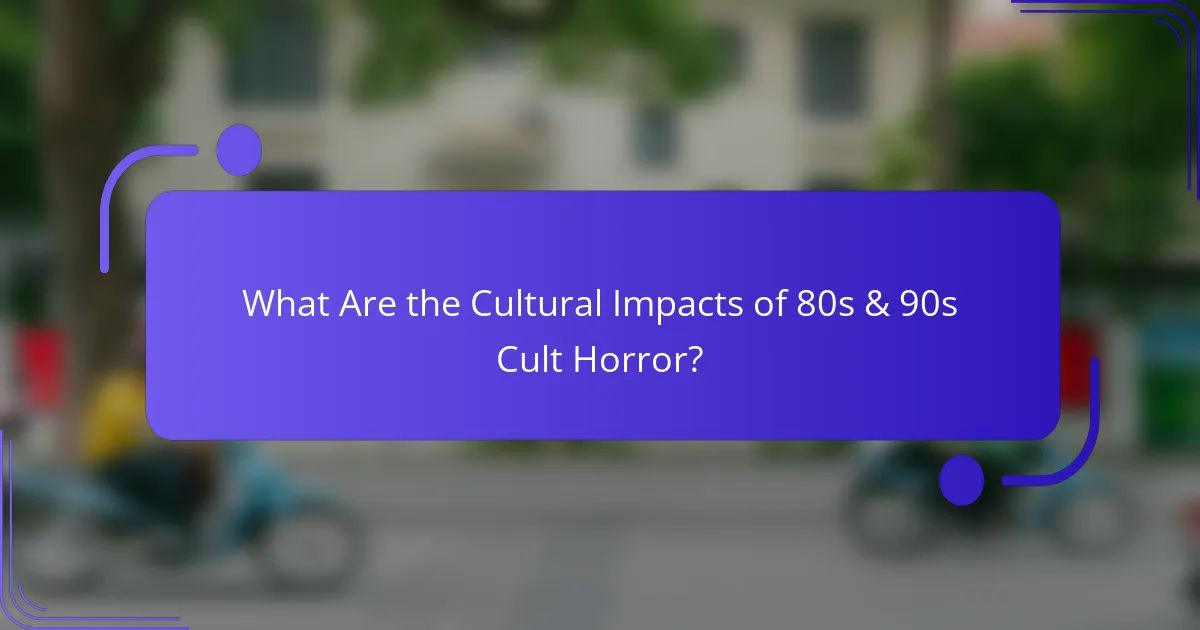
What Are the Cultural Impacts of 80s & 90s Cult Horror?
The cultural impacts of 80s and 90s cult horror are profound, shaping not only the genre itself but also influencing broader entertainment trends, societal fears, and community dynamics. These films introduced unique storytelling techniques and character archetypes that resonate with audiences even today.
Influence on Modern Horror
The legacy of 80s and 90s cult horror is evident in contemporary horror films, which often borrow narrative structures and plot devices from this era. Techniques such as meta-commentary, self-awareness, and blending of genres can be traced back to films like “Scream” and “The Blair Witch Project.” These innovations have paved the way for a more complex storytelling approach in modern horror.
Moreover, the use of practical effects and a focus on character-driven narratives have influenced filmmakers to prioritize authenticity over CGI. This trend can be seen in recent hits that evoke the gritty, visceral feel of classic cult horror, appealing to both nostalgia and new audiences.
Fandom and Community Building
The cult status of 80s and 90s horror films has fostered vibrant fan communities that celebrate these works through conventions, online forums, and social media. Fans often engage in discussions about themes, character arcs, and plot devices, creating a shared culture that keeps these films alive. Events like horror film festivals and themed screenings further strengthen these bonds among enthusiasts.
Additionally, the rise of merchandise and collectibles related to these films has created a thriving market. Items such as action figures, posters, and apparel not only serve as memorabilia but also as a means for fans to express their passion and connect with others who share similar interests. This sense of belonging is a key aspect of the cult horror phenomenon, ensuring its continued relevance in popular culture.
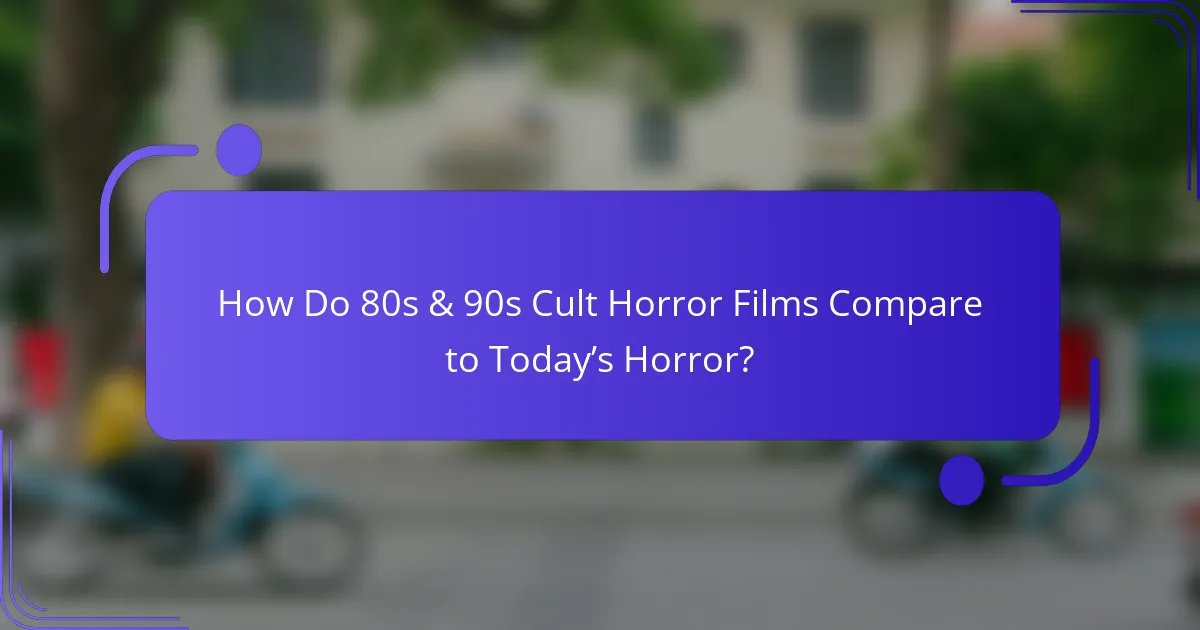
How Do 80s & 90s Cult Horror Films Compare to Today’s Horror?
80s and 90s cult horror films often feature unique plot devices and narrative structures that set them apart from contemporary horror. While today’s horror may rely heavily on psychological elements and social commentary, earlier films embraced campiness, practical effects, and straightforward storytelling.
Trends in Storytelling
Storytelling in 80s and 90s cult horror films often focused on simple, yet engaging plots that drew audiences in with memorable characters and shocking twists. These films frequently utilized archetypes, such as the final girl or the unsuspecting victim, to create tension and drive the narrative forward.
In contrast, modern horror tends to explore deeper themes and character development, often blurring the lines between good and evil. While this can lead to more complex narratives, it sometimes sacrifices the straightforward thrills that defined earlier cult classics.
Examples of effective storytelling from the past include films like “A Nightmare on Elm Street,” which combined supernatural elements with relatable teenage issues, and “The Evil Dead,” which balanced horror with dark humor. These films showcased how engaging plots and distinct characters can resonate with audiences, a principle that remains relevant today.
